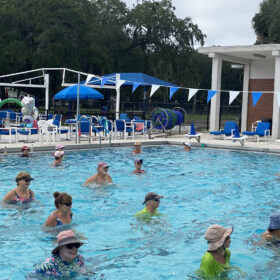By Pat Foster-Turley

It’s hot out there! Everyone I pass on the street is sweating and looking uncomfortable and everyone seems to have a comment about the heat. Yes, it’s Florida and heat is expected in the summer. But this? What with the high temperatures and the high relative humidity these past days, the heat index regularly reaches above 110 degrees, too hot for most of us to enjoy being outside.
We are among the lucky ones here in Fernandina Beach. We have a city pool at the Atlantic Avenue Recreation Center that is cooled through a system of heat pumps/coolers to a temperature no higher than 83 degrees. We seniors that are regular attendees at our water aerobics classes can get some exercise and commune with our pool buddies without breaking a visible sweat (although who knows how much sweat has dissolved in the water, ugh?). People with their own pools right now are rarely as happy, since the high day and night temperatures have made many pools too warm to swim in.
And then, of course, we have the ocean. These days the surf temperature is upwards of 85 degrees, still very comfortable for all to experience. Lately, I have been going right from the morning water aerobics class to the ocean for a quick relaxing soak. Heck, my bathing suit is already wet, the surf is often calm, and, since I don’t intend to stay long I don’t need to lug a chair, umbrella or much more than my water bottle and a towel. Perfect. All around me, I see others who have gravitated to the beach to stay cool, some with chairs placed in the surf, others a bit more adventurous out in the waves.

That’s great for us humans but what about other species that live here and are suffering the same heat? Take gopher tortoises for instance. These land-bound chelonians dig deep burrows in the ground that provide a cooler environment down deep. These burrows certainly help the tortoises keep cool, but more than that they provide a cool shelter for a myriad of other species from mice to snakes to insects. Sometimes gopher tortoises leave their dune habitats to take a stroll down the beach to take a dip in the surf. Maybe this is another cooling strategy for them, or maybe they are removing parasites, no one really knows for sure, but this is a natural behavior on their part.
This tortoise trait comes to my attention each year by some concerned beach-goer that finds a tortoise heading into the water. Some think it’s a sea turtle and try to help it by pushing it back in the water. NO. Tortoises have all the swimming ability of a cinder block and will drown if in too deep. All they want to do is take a shallow dip, then walk back to their inland burrow once again.

And speaking about walking, these tortoises have tough calloused feet designed for walking on hot sand, a feature that most other animals lack. Dogs do not have such an adaptation, and walking on hot sand or asphalt burns their feet just like it would burn yours. Hopefully, all dog owners are aware of this, but it doesn’t hurt for another reminder here.
Other animals in our realm also adjust to heat spells. They reduce their activity in the heat of the day, and find shady places to rest until the temperatures fall. Plants are less tolerant, and long stretches of overly hot days, combined with lowered rainfall, stress a number of trees and plants, and, if it lasts too long, can cause them to die. Other species, however, are more adapted to hotter weather, and gradually as our climate changes with fewer cold spells and higher temperatures, these species extend their range north. A clear example of this is the northward extension of the range of mangroves, species most recognize from south Florida – but now small pockets of black mangroves can even be found in our own county. Various other species, like lizards, are also settling further north. There are even cases reported of green iguanas on Amelia Island and it remains to be seen if the weather will be cold enough next winter to deter them.
All is fine for those species that seek warmer weather, but what about those species up north or on mountaintops where cold is required for their existence? They have no place to find cooler temperatures when their environment warms up. And those species confined to pockets of habitat like lakes and islands? Where do they go? And what about sedentary corals that cannot stand warmer water? They are already bleaching and dying out in the Florida Keys and elsewhere as the temperatures rise. The host of other species depending on these corals are threatened too.

We humans with resources can beat the heat but others can’t. Think about the homeless people in our community or those too poor to afford electricity to power air conditioners. These times are stressful for them. And for those species that cannot beat the heat, their days on Earth are numbered.
Pat Foster-Turley, Ph.D., is a zoologist on Amelia Island. She welcomes your nature questions and observations. [email protected]
